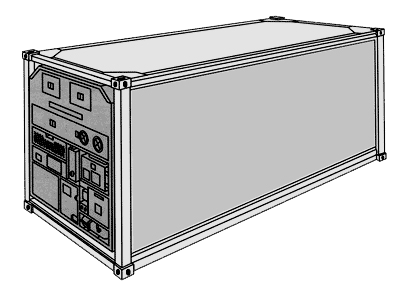The presented container types are the most commonly used in the overseas transport of goods. Forwarding agents and trade companies are the groups the information included in these descriptions is aimed at. More specific construction, stowing, stacking, handling details are to be obtained at shipping agents and terminal operators. The dimensions of particular containers of the same type differ depend on the shipping line and the year of production. The numbers given below are approximate. In case the cargo dimensions and/or weights are close to the limits, please contact us for advise.
Container types
| Container 20ft x 8ft x 8ft 6 in (6,1m x 2,4m x 2,6m) | |||||
| Approximate inside dimensions | Approximate door openings | Approximate capacity | |||
| Length | Width | Height | Width | Height | |
| 5,890m | 2,345m | 2,400m | 2,335m | 2,290m | 33,3 m3 |
Steel framework of the container consists of corner posts, bottom side rails and cross members, top side rails, a front top end rail and a door header. Container floor must be strong enough to bear both the container load and forklift truck. Lashing rings on the internal rails and floor facilitate lashing of the cargo inside the container.
The strongest load-carrying elements of the container are corner posts. They are ended with corner castings allowing container handling and stacking Container doors are equipped with locks fitted for seals and padlocks. Double, watertight doors are attached to the container with hinges welded to front corner posts.
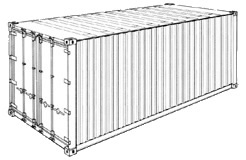
Container roof is the weakest part of the container and must not be covered with any cargo. General purpose containers are suitable for carrying all types of general cargo. After modifications they can also carry bulk as well as liquid loads. In order to stow bulk cargo in the container it must be loaded into one Big Bag inlet and unloaded using pneumatic equipment or chassis with tipping ending. Neutral liquids are carried in flexitanks lashed inside the container – this option could be cheaper than transporting liquids in Tank Containers.
Tare weight of the container equals from 1,8 to 2,5 t. Average payload – 21,8t.
ATTENTION: Estimating weight of the cargo for loading into the container not only container max. payload but also national road and rail traffic limitations along with vehicle specification must be considered.
| Container 40ft x 8ft x 8ft 6 in (12,2m x 2,4m x 2,6m) | |||||
| Approximate inside dimensions | Approximate door openings |
Approximate capacity
|
|||
| Length | Width | Height | Width | Height | |
| 12,015m | 2,345m | 2,362m | 2,335m | 2,260m | 66,9 m3 |
General Purpose Container 40′ is similar in construction and characteristics to 20′ container General Purpose Container 20′. External dimensions allow for stowing into it two 20’containers leaving 3-foot space in between. Loaded 40′ containers must be handled by corner castings. Tare weight varies depending on the serial number of the container – approx. 3,9t. Payload equals approx. 26t.
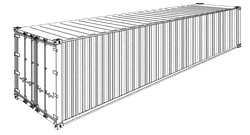
ATTENTION: The common mistake is to calculate the payload of 40′ container by adding payload of two 20′ containers which equals approx. 43,60t.
|
Container 40’HC – 40ft x 8ft x 9ft 6 in (12,2m x 2,4m x 2,9m) |
|||||
|
Approximate inside dimensions |
Approximate door openings |
Approximate capacity |
|||
|
Length |
Width |
Height |
Width |
Height |
|
|
12,015m |
2,345m |
2,690m |
2,335m |
2,580m |
76m3 |
|
Container 45’HC – 45ft x 8ft x 9ft 6 in (13,7m x 2,4m x 2,9m) |
|||||
|
Approximate inside dimensions |
Approximate door openings |
Approximate capacity |
|||
|
Length |
Width |
Height |
Width |
Height |
|
|
13,556m |
2,345m |
2,690m |
2,335m |
2,580m |
86m3 |
High Cube Containers differ from the standard 40‘ container in the outside height which equals 9’6″ (2,895mm) and in the leght (45’ HC Container). Consequently the capacity of 40′ HC is approx. 10m3 bigger than the capacity of the 40′ container and the capcity of 45’ HC is 20m3 bigger. High Cube Containers are suitable for light, voluminous and overheight cargo not fitting the standard container. These containers must be transported on Gooseneck semi-trailer (max. height – 1,1m) to meet road gauge limits. Transporting High Cube Containers on higher semi-trailers is possible only by obtaining special permits.
Tare weight and payload of High Cube Containers does not differ significantly from weights of the 40′ container. On average: tare weight of 40’HC is 4,2 tonnes and payload is 26,5 tonnes, tare weight of 45’ HC is 4,8 tonnes and payload 26 tonnes.
An increase of High Cube Container units in the total number of containers is observed recently. This tendency is caused by the change in the range of transported goods.
| Type | 40’PW | 45’PW |
| Approx. inside dimensions [m] | ||
| length | 12,100 | 13,556 |
| width | 2,426 | 2,444 |
| height | 2,694 | 2,695 |
| Door openings [mm] | ||
| width | 2,360 | 2,416 |
| height | 2,585 | 2,585 |
| Weight [kg] | ||
| Tare | 4,150 | 4,660 |
| Payload | 29,850 | 29,340 |
| Capacity [m3] | 79,1 | 89,2 |
| Pallet capacity [szt.] | ||
| Europallet [1200×800] | 30 | 33 |
| Pallet [1200×1000] | 24 | 27 |
Palletwide container is constructed similarly to 40′ General Purpose Container. The main difference is the bigger width allowing stowing into it two 1200×1000 pallets or three 1200×800 pallets. Consequently 40’PW can be loaded with 30 1200×800 pallets, 45″PW with 33, 40′ general Purpose Container only with 25 pallets. The payload of the 45’PW equals the payload of the semi-trailer. Palletwide containers are mainly used is short sea shipping (European destinations) to compete with road transport.
Schematy wypełnienia kontenerów europaletami
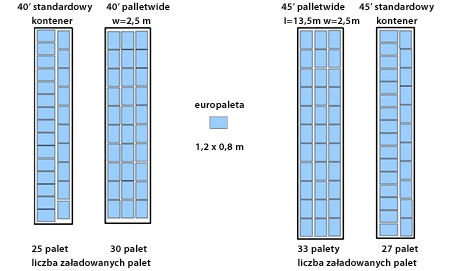
| Open Top Container 20ft x 8ft x 8ft 6 in (6,1m x 2,4m x 2,6m) | |||||
| Approx. roof dimensions [m] | Approx.capacity | ||||
| Length | Width | ||||
| A | B | C | D | E | |
| 5,700m | 5,080m | 2,200m | 1,505m | 1,850m | 32,4 m3 |
| Approx. door openings [m] | Approx. capacity | ||||
| Width | Height | ||||
| F | G | H | I | K | |
| 2,315m | 1,680m | 2,200m | 2,080m | 1,860m | 32,4 m3 |
Open Top containers are suitable for carrying the loads which can not be stowed into the container through the door or/and exceed the height of the standard container. Open Top Container allows for cargo loading from the top and door side by cranes and overhead tackles. The roof of the container is covered with spray-tight tarpaulin secured by the customs seal. The floor and walls are equipped with numerous lashing devices. The floor capacity regarding fork-lift truck stowage exceeds ISO standard by 33%.
ATTENTION: tare weight and payload of the Open Top Containers differ significantly depending on serial number and shipping line the container belongs to. The exact weight of the particular container must be verified before loading.
Open Top Containers are more commonly used for carrying bulk loads. The cargo is loaded from the top side and unloaded using end tipper semi-trailer..
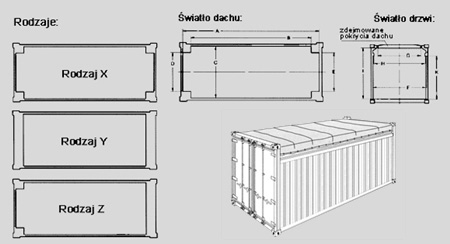
Hardtop Container is constructed for carrying heavy and overheight loads which are difficult to be packed into the standard container. To facilitate the process of loading Hard Top Container is equipped with removable roof and door header. The roof is made of steel and weights approx. 450kg. It can be lashed to the side wall inside the container using 13cm of space if the cargo is overhigh. Hardtop Containers belongs to the group of special purpose containers and consequently the freight fee could be much higher than the shipment of the standard container.
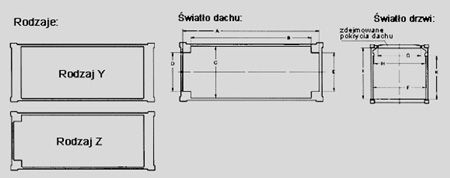
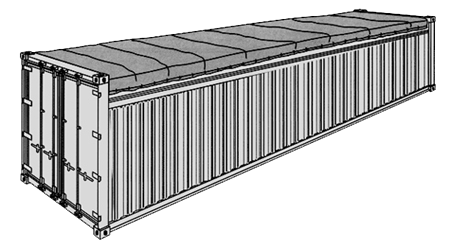
| Flat rack 20ft x 8ft x 8ft 6 in (6,1m x 2,4m x 2,6m) | |||||
| Approx. inside dimensions | Approx. inside capacity | ||||
| Length | Width | Height | |||
| 5,940m | 2,400m | 2,310m | 31,9 m3 | ||

| Flat rack 40ft x 8ft x 8ft 6 in (12,2m x 2,4m x 2,6m) | |||||
| Approx. inside dimensions | Approx. inside capacity | ||||
| Length | Width | Height | |||
| 12,066m | 2,263m | 2,134m | 58,6 m3 | ||
Flatrack container is designed to carry especially heavy load and overwidth cargo. It consists of strong bottom construction and end walls. There are numerous lashing devices on the longitudinal rails and floor. On special request, flatrack can be equipped with stanchions to limit the size of the cargo and to facilitate the process of loading.
ATTENTION: Flatracks are delivered without tarpaulins. Consequently, the cargo loaded on the flatrack should be appropriately packed to be protected against extreme weather conditions (e.g. during the carriage on the vessel deck).
The floor of the flatrack container is significantly high – in 20′ flatrack it measures approx. 30 cm and in 40′ – 60cm. This limits the road haulage of oversized cargo on flatrack containers. It is very often cheaper and easier to transport oversized pieces on standard e.g. tarpaulin truck and re-load it on flatrack container in the port of loading.
Particularly large items of cargo which can not be stowed into the containers are placed on “tween deck” constructed from two or more flats (during the carriage on a vessel, in port to port destinations). Shipping cargo in this way is complicated and costly but in many cases it is the only solution for the transport of oversized elements.
The length of Platform is similar to that of 20′ and 40′ containers. Platforms are suitable for carrying heavy and oversized loads. Max. payload of 40′ platform equals approx. 40t and is significantly bigger than payload of other containers. Strong bottom construction allow transporting concentrated loads. Using combination of several platforms “tween deck” can be constructed on a vessel to facilitate the transport of break loads. Platform is equipped with strong lashing devices on the longitudinal rails.
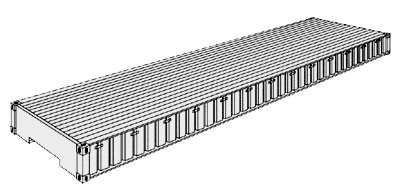
| Container 20ft x 8ft x 8ft 6 in (6,1m x 2,4m x 2,6m) | |||||
| Approx. inside dimensions | Approx.door openings | Approx. capacity | |||
| Length | Width | Height | Width | Height | |
| 5,540m | 2,260m | 2,247m | 2,260m | 2,200m | 27,7m3 |
| Container 40ft x 8ft x 8ft 6 in (12,2m x 2,4m x 2,6m) | |||||
| Approx. inside dimensions | Approx.door openings | Approx. capacity | |||
| Length | Width | Height | Width | Height | |
| 11,500m | 2,270m | 2,200m | 2,270m | 2,170m | 57,8m3 |
Refrigerated Containers are designed to carry the cargo requiring the constant temperature.
“Sandwich-construction” walls are filled with Polyurethane foam. Aluminium T-gratings in the floor serve as air channels. The reefer unit automatically adjusts the temperature to the required level (available scale approx. from +25°C to -25°C) as long as the difference between outside and load temperatures does not exceed 42°C for heating and 65°C for cooling.
The cargo must be stowed into the container in a way to ensure 75 mm of space between the roof and the surface of the load. Possible voltages: 380V/50 Hz to 460V/60 Hz and 200V/50 Hz to 220 V/60 Hz.
